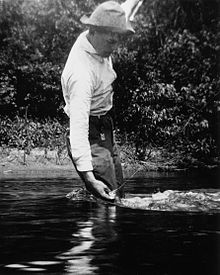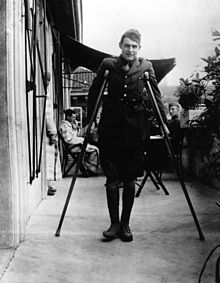Now I Lay Me
Now I Lay Me is a short story by Ernest Hemingway that was first published in the anthology Men Without Women in 1927 . The German translation by Annemarie Horschitz-Horst is titled I'm tired, go to rest . The text deals with the effects of post-traumatic stress disorder as a result of the First World War and the actions of the so-called war tremors .
content
First-person narrator is Nick Adams , who, after being seriously wounded, believes his soul will leave his body if he falls asleep in the dark. Therefore he stays awake at night. He thinks very intensely about fishing and angling and literally makes dream trips to different streams. He pursues these journeys with great attention to detail and repeatedly has the problem of not having any bait in his imagination, revealing to the reader what can be used as bait when there are no more worms. In the end he thinks of places where he could fish, but there too he runs into his problems with the baits.
Some nights Nick finds it impossible to think about fishing, so he tries to say prayers for everyone he has ever known. He also tries to remember everything before going to war. He thinks above all that after the death of his grandfather, they moved out of the house where he was born and burned everything they didn't want to take with them in a big fire in the garden. He later thinks of a similar scene; in this memory his mother had cleaned up the house and burned Nick's father's belongings while he was on a hunting trip. When the father returned he tried to save what he could, but the best of it was destroyed by the fire in the garden.
On some other nights, Nick has difficulty remembering the wording of the prayers. That is why he cannot pray and deals with almost childish tasks, such as naming all animals or cities in the world. Nick is another man in the room who is also awake because he has insomnia. They're talking, Chicago , because they both work there and the other man, who Nick calls "John", calls Nick "Signor Tenente". Finally, the issue of women comes up. John maintains a lively correspondence with his wife and cannot believe that Nick is unmarried. He suggests that he look for a pretty Italian girl and get married on the spot, or choose the one at home who has the most money. Nick is reluctant to respond.
Nick and John finally decide to get some sleep, whereupon Nick hears him on the mattress. He himself thinks of all the girls he has ever known and wonders what kind of wives they would make, but over time, he finds, they become blurred and all appear the same. So Nick prays again, also for John. He is happy that his class has been withdrawn from the front. Nick then reports about later and how John had visited him in the hospital in Milan and was beside himself because Nick was still unmarried. The narrator then concludes that John would be even more speechless if he knew that Nick still had not married. In John's opinion, Nick concludes, that marriage would straighten things out.
Themes and motifs
In the story, Nick Adams, Hemingway's biographical alter ego , calls up his life stations in order not to have to fall asleep. He suffers from the delusion that his soul will leave his body as soon as he falls asleep. This goes back to a feeling that Nick suffered the moment he was wounded. Nick's self-imposed sleep deprivation contrasts with the real insomnia of John, who would like to be able to sleep, which he actually manages at the end of the story. Nick, on the other hand, only sleeps in daylight because his soul, so his delusion, would only leave his body in the dark. In fact, he later knows, looking back, that while trying to stay awake, he certainly fell asleep several times, but then perceived it differently.
Nick's fear stems from a post-traumatic stress disorder that many soldiers suffered, particularly during World War I. In the case of soldiers, one speaks of so-called war tremors . The Two Thousand Yard Stare was also seen among soldiers during World War I. Hemingway's portrayal is an authentic narrative, possibly based on personal experiences, about what appears real to a soldier in this form of stress disorder. The idea that the soul would leave the body when it was asleep was rejected as a delusion by Nick in later years, but at the moment it appeared it seemed completely real and threatening. This fear could possibly be due to the fact that Nick Adams / Ernest Hemingway was afraid of losing a form of humanity during the war. This does not necessarily have to be about one's own deeds, but rather through what one perceives and accepts passively or actively.
Another motif are the silkworms that Nick hears eating at the beginning and during the story. They stand for the unshakable likeness of nature, that it ultimately remains the same, but is perceived differently. Nick and John hear them "nibble," which Nick finally says is "weird". The world as Nick knew it is forever out of control and difficult to straighten out.
The wife's sanctuary suggested by John doesn't seem particularly helpful to Nick. He carefully circumvents John's remarks and, towards the end of the story, states that he has still not married. Despite his doubts, he mentions what John thinks of marriage: it makes everything right.
Autobiographical traits
How far the text was inspired by Hemingway's own war experiences on the Italian front is not entirely clear. In fact, however, Hemingway has worked through many of his war experiences in short story form with Nick Adams as the protagonist. Like this one, Hemingway was badly wounded and was in a Milan hospital. These experiences also formed the basis for further short stories from Hemingway.
Like the self in the story, Hemingway, after being wounded on the Italian front in 1917, was unable to sleep without a light for a long time.
Carlos Baker reports in his Hemingway biography that immediately after his war injury under artillery fire, the author lay seriously wounded in a small shed at the front before he could be transported to the hospital. He is said to have prayed: "Now I lay me".
title
The title of the American original goes back to the child's bed prayer Now I Lay Me Down to Sleep from the 18th century. The German title is taken from the most famous German-language child's bed prayer, I'm tired, I'm going to rest .
Web links
Individual evidence
- ↑ To identify the narrator as Nick Adams, see Phillip Young: Ernest Hemingway . Translated by Hans Dietrich Berendt, Diedrichs Verlag, Düsseldorf u. a. 1954, without ISBN, p. 34.See also Carlos Baker: Hemingway - The Writer as Artist , Princeton University Press, 4th ed. 1972, p. 229.
- ↑ See Phillip Young: Ernest Hemingway . Translated by Hans Dietrich Berendt, Diedrichs Verlag, Düsseldorf u. a. 1954, without ISBN, p. 37. Despite the biographical correspondences and similarities between Nick and Hemingway, the fictional narrative character of Nick Adams should not be equated with the real author. See ibid., P. 39 f. See also Carlos Baker: Hemingway - The Writer as Artist , Princeton University Press, 4th ed. 1972, p. 128.
- ↑ On the interpretation of Nick's insomnia and attempts to distract oneself by preoccupation with harmless things, see also Phillip Young: Ernest Hemingway . Translated by Hans Dietrich Berendt, Diedrichs Verlag, Düsseldorf u. a. 1954, without ISBN, p. 34 f.
- ^ Ernest Hemingway: Gesammelte Werke , Volume 6, Stories I, Rowohlt, Reinbek bei Hamburg 1977, p. 441, ISBN 3-499-31011-2 .
- ↑ page 445
- ↑ For details on the autobiographical background, see Carlos Baker: Ernest Hemingway - A Life Story , The Literary Guild, London 1969, pp. 61–82. See also Phillip Young: Ernest Hemingway . Translated by Hans Dietrich Berendt, Diedrichs Verlag, Düsseldorf u. a. 1954, without ISBN, p. 37 ff.
- ↑ Phillip Young: Ernest Hemingway . Translated by Hans Dietrich Berendt, Diedrichs Verlag, Düsseldorf u. a. 1954, without ISBN, p. 37.
- ^ Carlos Baker: Ernest Hemingway - A Life Story , The Literary Guild, London 1969, p. 69.




